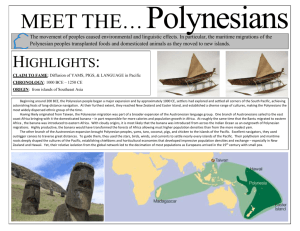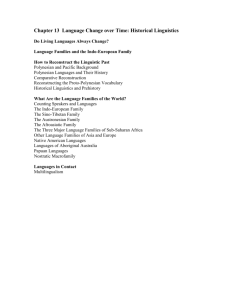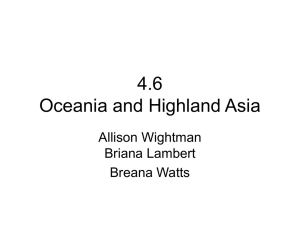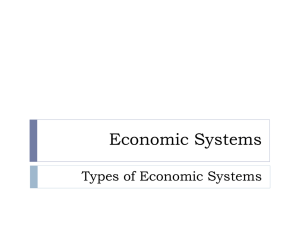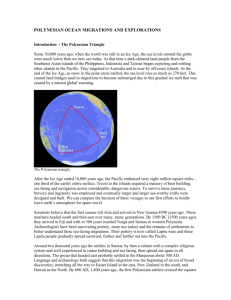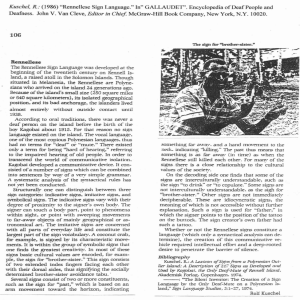Doc - NSW Syllabus
advertisement
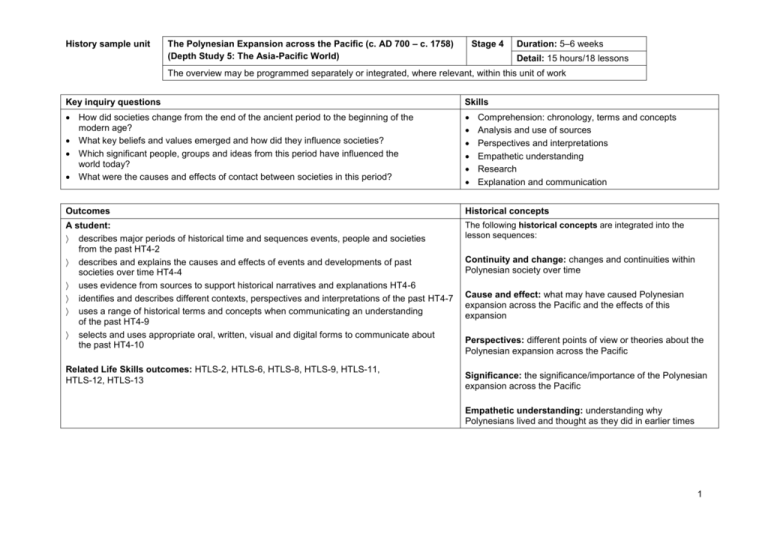
History sample unit The Polynesian Expansion across the Pacific (c. AD 700 – c. 1758) (Depth Study 5: The Asia-Pacific World) Stage 4 Duration: 5–6 weeks Detail: 15 hours/18 lessons The overview may be programmed separately or integrated, where relevant, within this unit of work Key inquiry questions Skills How did societies change from the end of the ancient period to the beginning of the modern age? What key beliefs and values emerged and how did they influence societies? Which significant people, groups and ideas from this period have influenced the world today? What were the causes and effects of contact between societies in this period? Outcomes Historical concepts A student: describes major periods of historical time and sequences events, people and societies from the past HT4-2 describes and explains the causes and effects of events and developments of past societies over time HT4-4 uses evidence from sources to support historical narratives and explanations HT4-6 identifies and describes different contexts, perspectives and interpretations of the past HT4-7 uses a range of historical terms and concepts when communicating an understanding of the past HT4-9 selects and uses appropriate oral, written, visual and digital forms to communicate about the past HT4-10 The following historical concepts are integrated into the lesson sequences: Related Life Skills outcomes: HTLS-2, HTLS-6, HTLS-8, HTLS-9, HTLS-11, HTLS-12, HTLS-13 Comprehension: chronology, terms and concepts Analysis and use of sources Perspectives and interpretations Empathetic understanding Research Explanation and communication Continuity and change: changes and continuities within Polynesian society over time Cause and effect: what may have caused Polynesian expansion across the Pacific and the effects of this expansion Perspectives: different points of view or theories about the Polynesian expansion across the Pacific Significance: the significance/importance of the Polynesian expansion across the Pacific Empathetic understanding: understanding why Polynesians lived and thought as they did in earlier times 1 Content Teaching, learning and assessment Theories about the origin and spread of Polynesian settlers throughout the Pacific (ACDSEH013) Study a NASA image of the Pacific Ocean (or any available map) showing its vast expanse, eg www.teara.govt.nz/en/pacific-migrations/1/1. Discuss what students already know about the Pacific Ocean while viewing the image. Students locate on their own map of the Pacific the major island groups they will be studying, eg Polynesia, New Zealand, Easter Island, Samoa. Students measure the great distances between the island groups and pose questions they would like answered during this unit of work. The following links may be useful: www.kids-world-travel-guide.com/pacific-ocean-facts.html www.newworldencyclopedia.org/entry/Polynesia. Using a range of sources, list the key natural features of Polynesia. Explain that students will be examining the various theories about the origin and spread of Polynesian settlers throughout the Pacific. Introduce students to the waka (canoe), the main form of seafaring of the Polynesians, and complete the following tasks: Students sketch an image of an early waka: www.teara.govt.nz/en/waka-canoes/1/2/1. Label the following features of the early waka, including the hiwi (hull or body of the boat), the tauihu (prow or front), the taurapa (stern or back) and the rauawa (gunwales or upper edges along each side). Discuss the significance of the addition of sails to sea-going vessels and brainstorm ideas about the difficulties of navigating the Pacific Ocean using only the waka. What preparations would need to be made before such a journey? What provisions would be required? Further information on the double-hulled canoe can be obtained from this source: www.pbs.org/wayfinders/polynesian2.html. On a map of the Pacific, trace the lines of Polynesian migrations across the Pacific Ocean over time, including to New Zealand. Clearly label the regions settled by Polynesians. The following map would be a useful guide: www.teara.govt.nz/en/pacific-migrations/4/3. Discuss the possible reasons for these voyages. There are generally ‘push’ and ‘pull’ factors for such journeys. How might historians find the answer to this question? What sources might be available for historians and archaeologists? Create a timeline of the various waves of migration across the Pacific from AD 700–1300s. The following websites may be useful: www.teara.govt.nz/en/pacific-migrations/5 www.teara.govt.nz/en/pacific-migrations/6 www.teara.govt.nz/en/pacific-migrations/7 www.teara.govt.nz/en/pacific-migrations/8. Students investigate various theories of Polynesian migrations, including those of Thor Heyerdahl, relating to ancient crossings of the Pacific Ocean. Does Heyerdahl convincingly prove his theories? What evidence does he use? Excerpts from the film Kontiki could be used, as well as the following links: www.teara.govt.nz/en/pacific-migrations/5/1 2 Students: identify the geographic extent and natural features of Polynesia locate the Pacific regions settled by the Polynesians outline theories about the origin and spread of Polynesian settlers throughout the Pacific describe the different societies of Polynesia The way Polynesian societies used environmental resources (sustainably and unsustainably), including the extinction of the moa in New Zealand, the use of religious/supernatural threats to conserve resources, and the exploitation of Easter Island’s palm trees (ACDSEH068) describe key environmental resources of Polynesian societies assess Polynesian uses of environmental resources in this period The way of life in ONE Polynesian society, including social, cultural, economic and political features, such as the rule of ariki and related tribal roles in Maori and in Rapa Nui society (ACDSEH066) describe everyday life in ONE Polynesian society during this period www.kon-tiki.no/E-Exp_KonTiki.php www.newworldencyclopedia.org/entry/Thor_Heyerdahl. Investigate the research of Dr Erika Hagelberg and recent research from the University of Otago surrounding the theory that Polynesians originated from South East Asia (in contradiction to the Heyerdahl theory). Students record the evidence offered from both theories and prepare for a debate: ‘Thor Heyerdahl was not right!’ The following may be useful: www.independent.co.uk/news/science-dna-shows-how-thor-heyerdahl-got-it-wrong-1137388.html. Students view the following clip and discuss as a class the arguments for and against the following: Did Polynesians discover America?: www.history.com/videos/did-the-polynesians-discover-america#did-the-polynesians-discover-america. Using a range of sources, list the various Polynesian societies and construct a mindmap of the key features of Polynesian societies. Using a range of sources, briefly describe the key environmental resources of these societies. The class discusses the concept of an ‘Eden’ or untouched paradise. What visual images does this create in one’s mind? Students locate images on the internet or from other sources to represent such a paradise and compare these to images of Polynesian lands. View the following documentary (if possible) and focus on the environmental issues of sustainability confronting the first Maori (1200s): Monsters We Met, Part 3: ‘The End of Eden’ BBC 2008. The class researches and then discusses the following questions: What animals and plants did the Maori bring to New Zealand? What was the overall effect of Maori settlement on the environment? Aspects that could be researched could include the reasons for the effect this had on the hokioi (Haast’s Eagle); the effect the kiore (rats) had on New Zealand’s bird species. What impact did the dwindling natural resources have on Maori inter-tribal relationships from the fifteenth century? Explain how the tohunga (sacred priest) came to a spiritual understanding about the sustainability of New Zealand’s unique environment and what measure he made to ensure sustainability. Investigate other aspects of Polynesian use of the environment, including the exploitation of Easter Island’s palm trees. Resources that may be useful include: www.kcc.org.nz/moa/, www.archaeology.org/online/features/moa/ www.smithsonianmag.com/people-places/The_Mystery_of_Easter_Island.html. Maori society in New Zealand Using http://collections.tepapa.govt.nz/search.aspx?advanced=colCollectionType%3a%22Pacific+Cultures%22: Create a Pinterest from a series of objects displayed in the collection of the Museum of New Zealand, Wellington. Give each chosen image a suitable caption in the Pinterest. What do these objects reveal about everyday life in a Polynesian society? What aspects of society are not represented by this collection? Where might an historian find other evidence about this society? 3 describe key political features of ONE Polynesian society, including the role of the ariki explain key economic activities of ONE Polynesian society The cultural achievements of ONE Polynesian society, such as the Ta moko, the haka and hangi in Maori society and/or the moai constructed on Easter Island (ACDSEH067) using a range of sources, describe the cultural achievements of ONE Polynesian society As a class, collate a mindmap of what is known about everyday life, together with a main source for each aspect. The teacher guides students in examining the interactive map of New Zealand (see link below) and locating the names of the different tribes. Are there specific settlement patterns? Why do you think most tribes are located on the North Island? www.teara.govt.nz/en/iwi Investigate the traditional Maori tribal and sub-tribal structure – the role and structure of iwi, hapu and whānau. The following may be useful: www.teara.govt.nz/en/tribal-organisation/1 www.teara.govt.nz/en/tribal-organisation/4 www.teara.govt.nz/en/1966/Māori-social-structure/2. Create a flow diagram, clearly labelling the tribal structure of Maori society. In what ways was the tribal structure of iwi, hapu and whānau a logical structure suited to the environment and society? Outline the social rank and roles of the ariki (paramount chief), rangatira (chief), tohunga (sacred priest) and kaumātua (elders) and the role of women, particularly the Kuia (female elder). www.teara.govt.nz/en/tribal-organisation/5 www.teara.govt.nz/en/kaumatua-Māori-elders/1 Discuss in class what particular skills (given by the gods and ancestors) the ariki and rangatira possessed. In what ways were the kaumātua also respected leaders? Explain the role of the tohunga in spiritual beliefs and practice. www.teara.govt.nz/en/nga-karakia-a-te-Māori-traditional-Māori-religion/1 Explain the importance of the whakapapa in Maori society. www.justice.govt.nz/publications/publications-archived/2001/he-hinatore-ki-te-ao-Māori-a-glimpse-into-the-Māoriworld/part-1-traditional-Māori-concepts/Māori-social-structures Using a range of sources, including the following webpage, explain the system of barter and the main goods traded by traditional Maori society. www.teara.govt.nz/en/nga-umanga-Māori-business-enterprise/1 Describe the purpose and importance of the Hākari feast. www.teara.govt.nz/en/nga-umanga-Māori-business-enterprise/1/1 Cultural achievements: students research the meaning of the pōwhiri and marae. What was the purpose of the pōwhiri for greeting visitors onto the marae? Students create a visitor’s guide to the protocols for visiting the marae, identifying key features. The following may be helpful: http://issuu.com/mauriglobal/docs/39311_powhiri?mode=window&backgroundColor=%23222222 www.yourepeat.com/watch/?v=uiNxufOYH-s&feature=youtube_gdata http://tvnz.co.nz/content/2686874/video. Ta moko (the tattoo): The class discusses what they know about the art of ta moko, or the tattoo. The teacher introduces the history of the word ‘tattoo’. It is a Polynesian word and is phonetic: the ‘tat’ refers to when the chisel-like implement that held the ‘ink’ is tapped with a shallow thud and the ‘too’ is a faster movement for when the ‘ink’ is actually imbedded into the skin. After watching the following, students research where these tattoos usually appear and what tools were used to construct a ta moko. Who could receive a ta moko? 4 ‘Polynesian Tattoos’, part of the Ancient Ink series on the History channel: www.polynesiantattoodesigns.org/polynesian-tattoos-history-channel-special Skin Stories: The Art and Culture of Polynesian Tattoo: www.pbs.org/skinstories/index.html www.pbs.org/skinstories/culture/index.html#tradition Students research four symbols that are used by Polynesian tatau artists, and reproduce the designs and explain their spiritual meaning. After viewing the following, students explain the significance of the ta moko to Polynesian society: www.nzonscreen.com/title/ta-moko-2007 (Ta Moko, screened on TVNZ, was a finalist at the 2007 NZ Media Peace Awards). Dispelling the myth of the haka: The class brainstorms their understanding of the haka today (such as performed by the All Blacks rugby team). Teacher explains that the movements in the haka are highly symbolic. It is a deeply spiritual dance and is performed at several different forums from initiation ceremonies to funerals or political and sporting events. Respect towards the study of this cultural achievement should be paramount. In groups, students research the topic ‘The haka is part of the Maori historical tradition’. Specific evidence is required to support their argument. The construction of a timeline may aid the process. The following provides an introduction to the haka: http://static.newzealand.com/visit/feature/haka/en/index_content.html. Empathy task: As a haka expert, explain the history, cultural importance and spiritual significance of the haka to an Australian audience. Your aim is to dispel the popular myths surrounding the haka and explain in depth its purpose and symbolic meaning in Maori society. Rapa Nui (Easter Island) The documentary The Mystery of Easter Island, BBC, 2002, may be revisited. Students construct an historical and archaeological guide to the island for tourists. The guide should include a simple timeline of human occupation on the island; a description of the Moai statues, providing some explanation of their possible purpose; a description of other archaeological finds; and a brief history of human occupation on the island referring to evidence. The following may be useful: www.teara.govt.nz/en/pacific-migrations/4/4 www.bbc.co.uk/science/horizon/2003/easterisland.shtml http://channel.nationalgeographic.com/channel/explorer/videos/easter-island-underworld/. Create a mindmap identifying the reasons for the collapse of Rapa Nui society. The teacher chooses an ‘Extension debating team’ to argue the following in front of the class: ‘The construction and use of the moai is Rapanui’s main cultural achievement and is evidence of a highly sophisticated Polynesian society’. 5 Resources Bellwood, P, The Polynesians: Prehistory of an Island People, London: Thames and Hudson, 1987 Freeman, DB, The Pacific, London: Routledge, 2010 Kirch, PV, On the Road of the Winds, Berkeley: University of California Press, 2000 Kirch, PV, The Evolution of the Polynesian Chiefdoms, Cambridge: Cambridge University Press, 1984 Kirch, PV and Green, RC, Hawaiki, Ancestral Polynesia, Cambridge: Cambridge University Press, 2001 McCall, G, Rapanui Tradition and Survival, Allen & Unwin, St Leonards, 1994 Orliac, C and Orliac, M, The Silent Gods: Mysteries of Easter Island, London: New Horizons, Thames and Hudson, 1995 6
